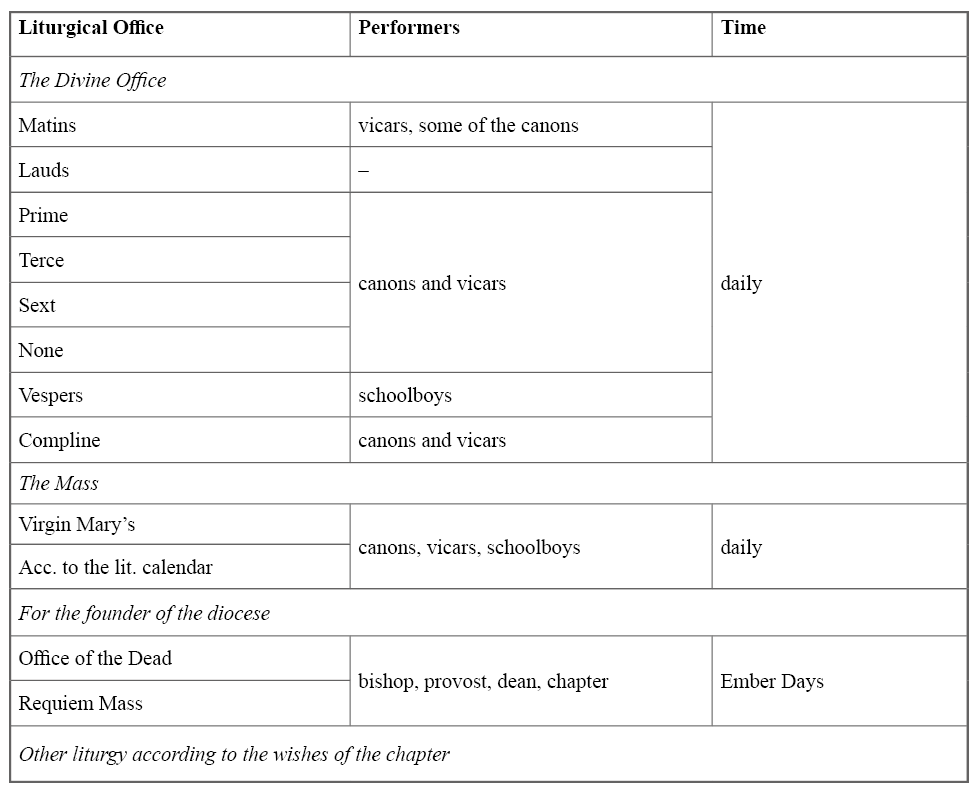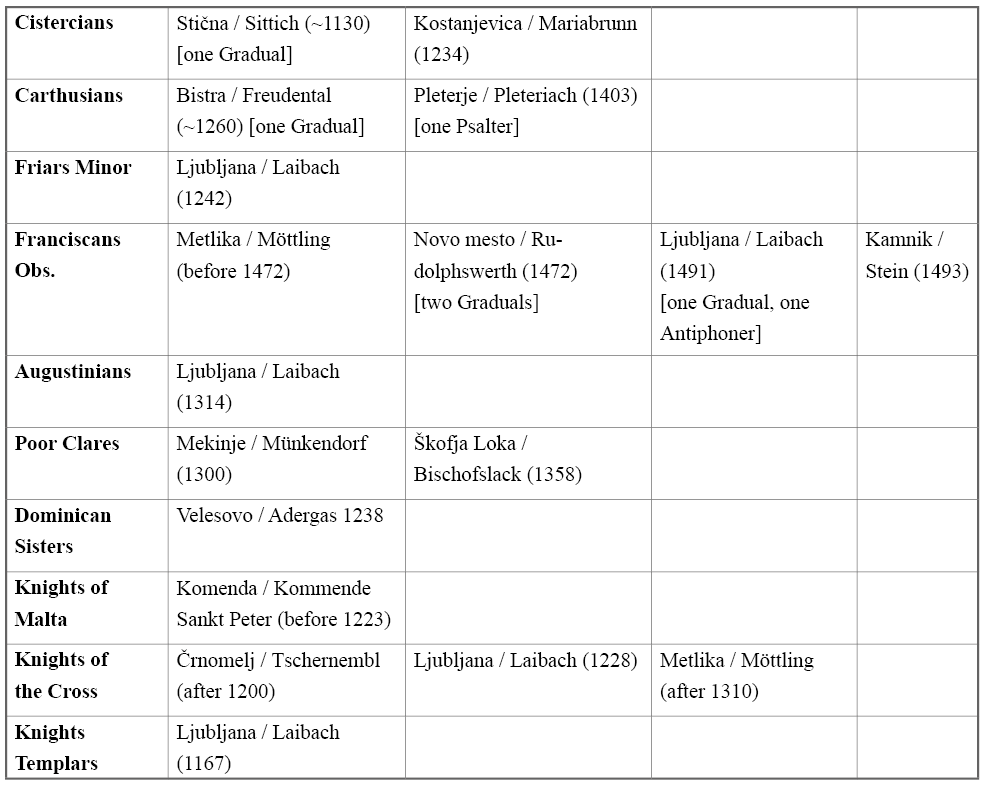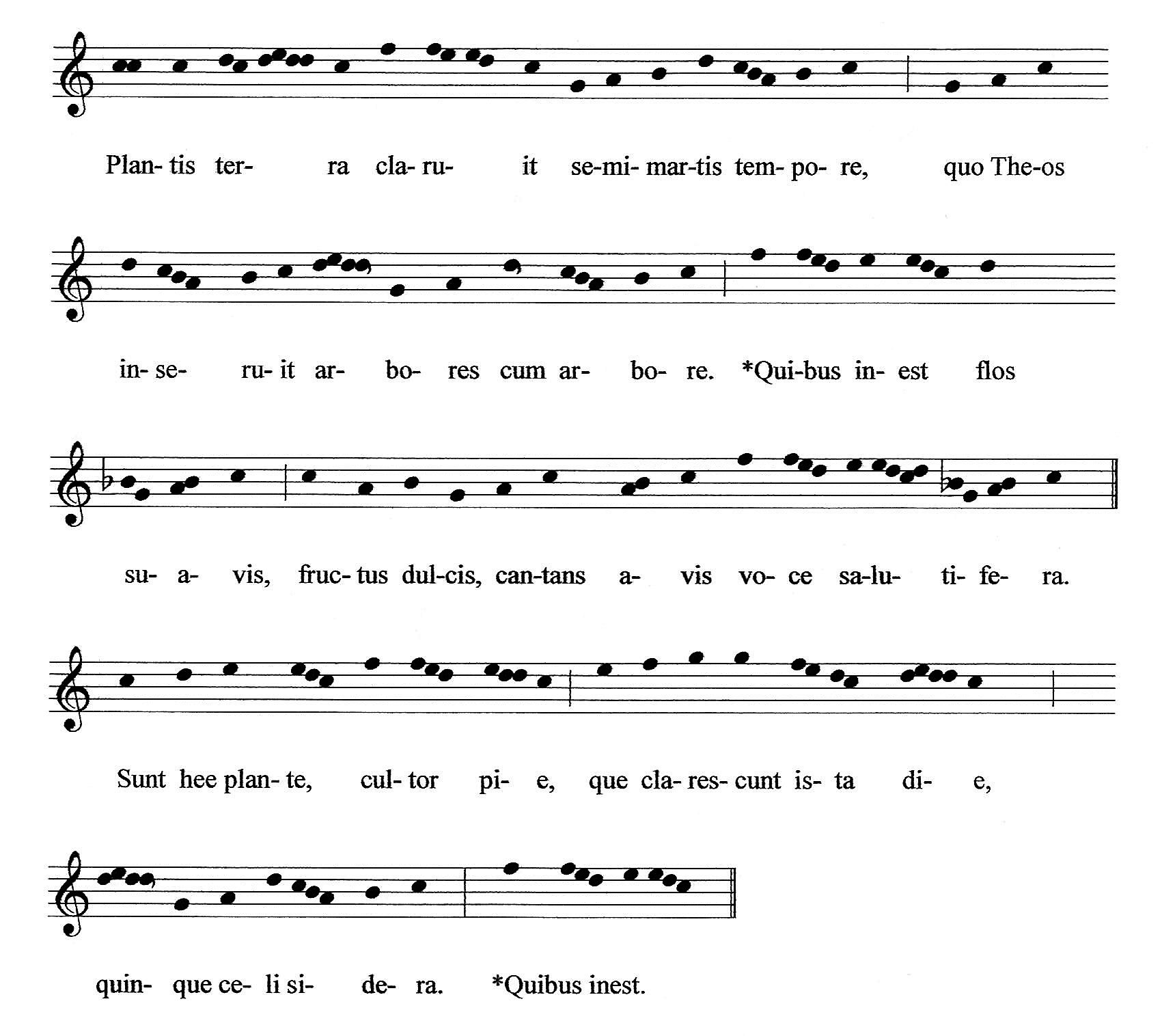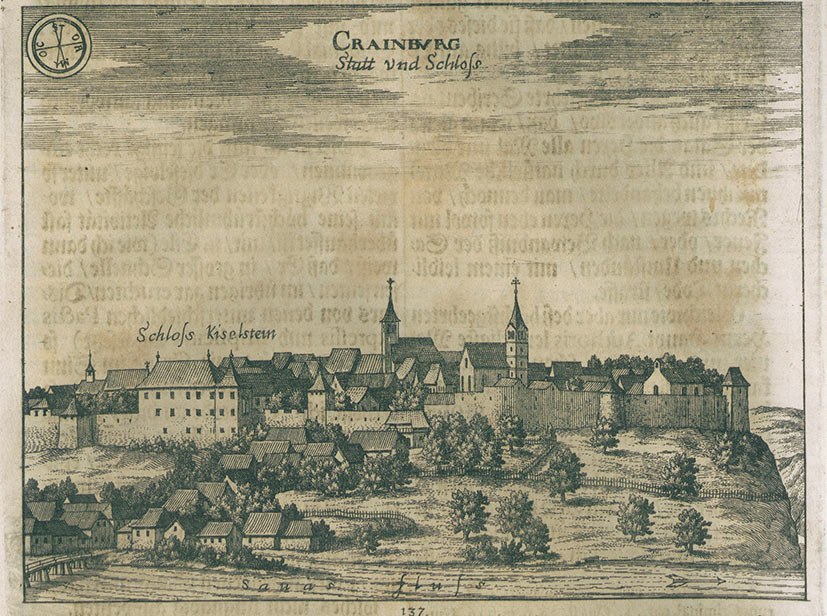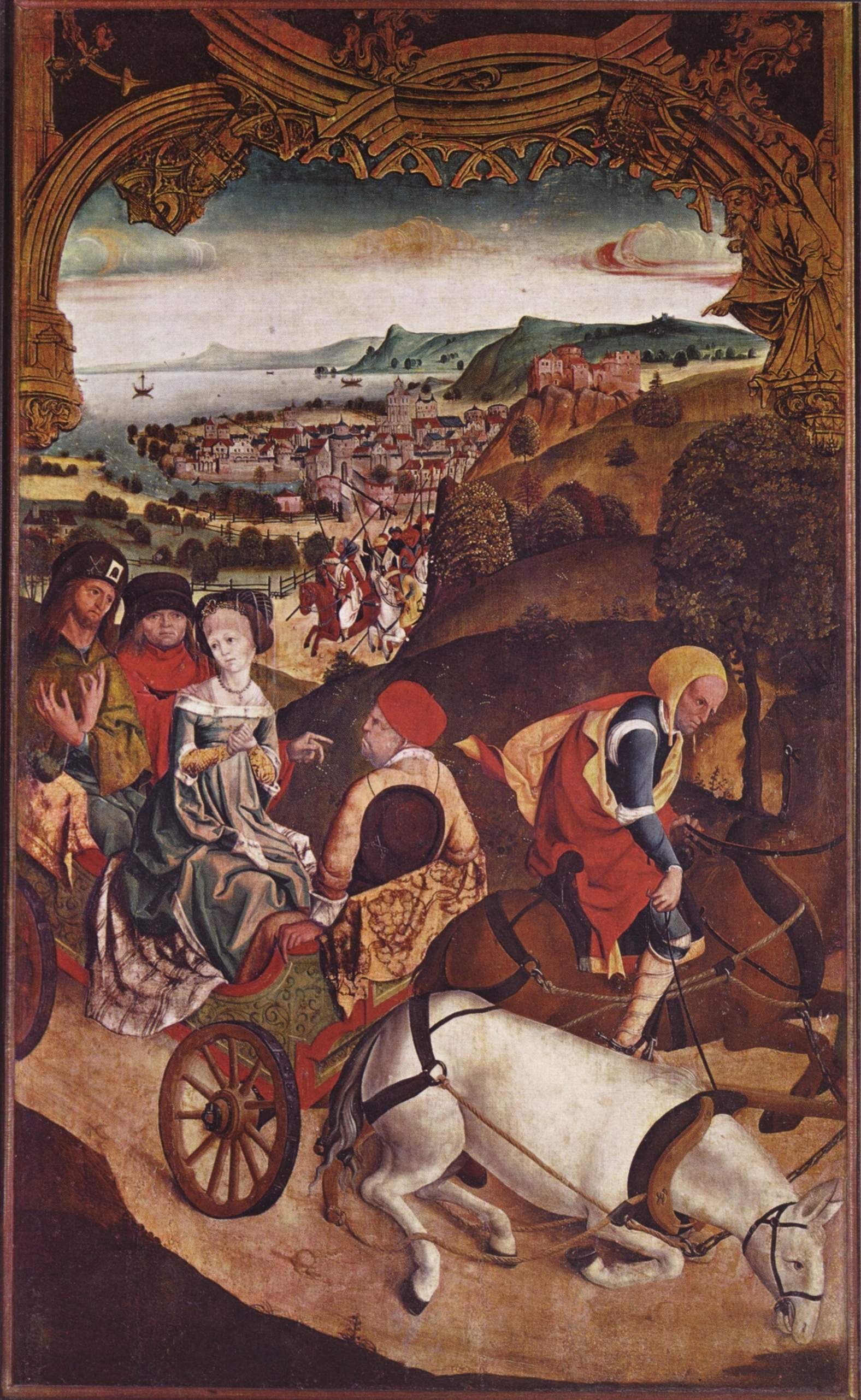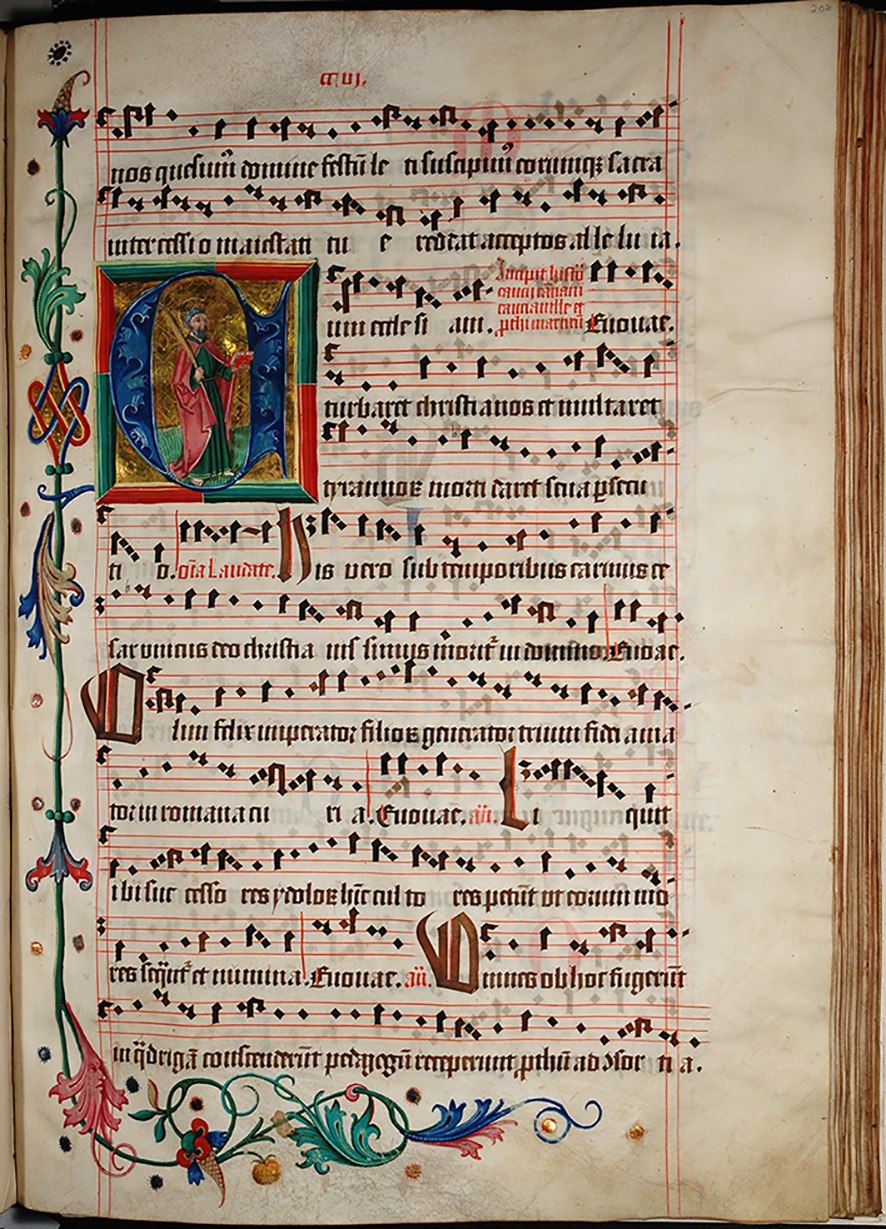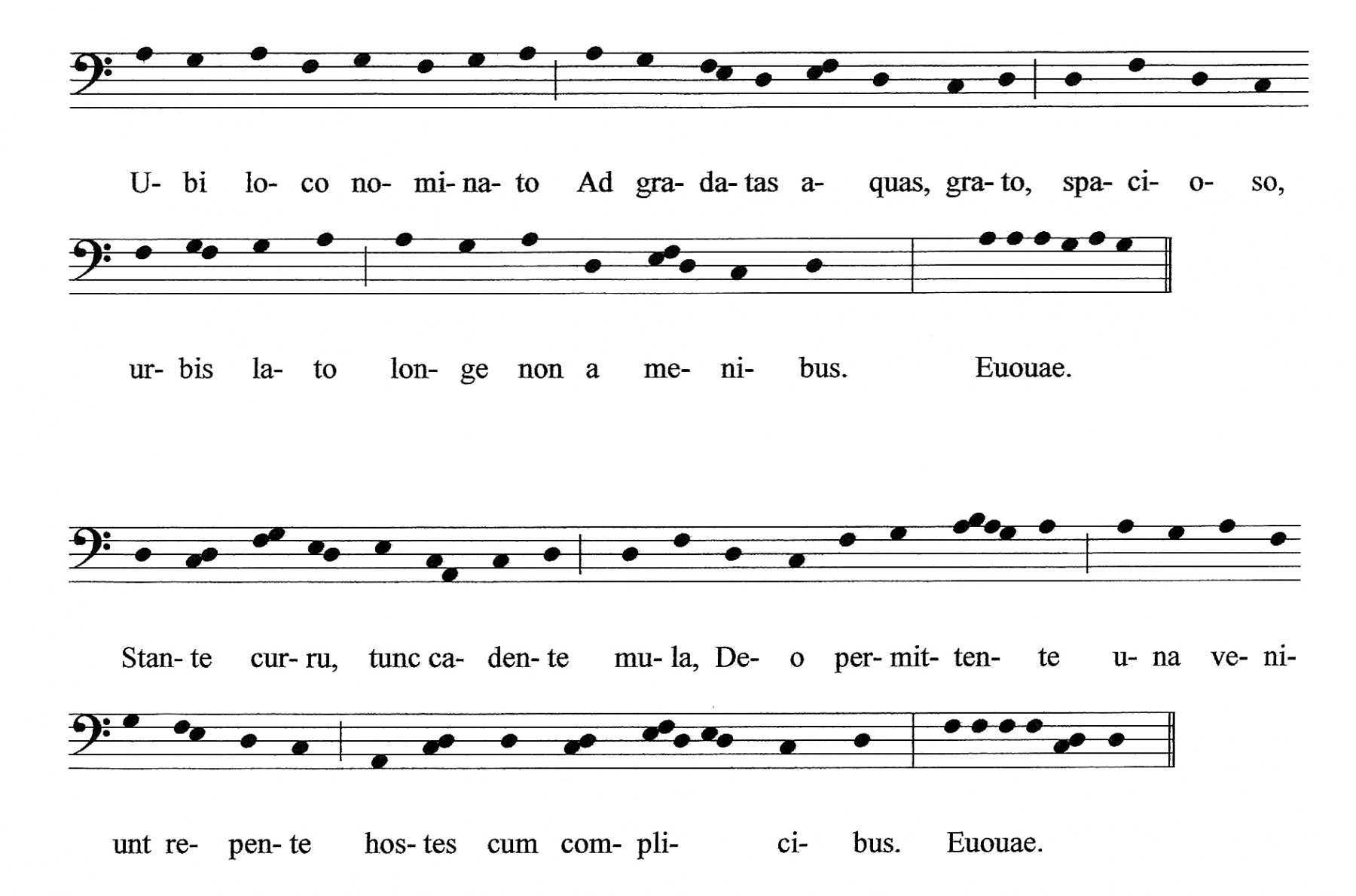Liturgical chant in medieval Carniola
The rite of Aquileia
In 811 Charlemagne decided that Carantania, in those times one of the principalities dependent on his Empire, should be divided between the Archdiocese of Salzburg and the Patriarchate of Aquileia, the borderline between both ecclesiastical metropolitan provinces being the river Drau / Dravus:
… predictam provinciam Karantanam ita inter se dividere iussimus, ut Dravus fluvius qui per mediam illam provinciam currit, terminus ambarum dyoceseon esset …[1]
The reason for this decision, as it is expressed in the decree itself, was to put an end to an old controversy between the two ecclesiastical provinces. The decision remained in force almost for a millenium – until the downfall of the Patriarchate under Joseph II.
Consequently, Carniola (Germ. Krain, Slov. Kranjska), which came into being as a southern margravate of Carantania around the turn of the millenium, belonged, as ecclesiastical matters were concerned, to the Patriarchate of Aquileia. The land was ruled by several powerful dynasties, until in 1335 it became one of the hereditary duchies of the House of Habsburg, remaining this until the collapse of the Austro-Hungarian Empire. There was no diocese in Carniola until 1461; since it was difficult to watch over vast territories far away from Aquileia, the domains in the east were divided into several archdiaconates.
As for liturgical matters it may be inferred that it was the rite of Aquileia that had to be used in the churches of the land. This is indirectly attested by the charter of the diocese of Ljubljana / Laibach; in 1461/1462 a new diocese was erected in the town that also functioned as the capital of Carniola; by this act the founder of the new diocese, Emperor Frederick III, tried to reduce the political influence of the Patriarchs in his lands. The new diocese, which originally did not encompass the whole of Carniola, was therefore exempted from the Patriarchate and directly subordinated to the Pope. Yet it was the rite of Aquileia that was expressly prescribed as the liturgical norm of the new diocese in its charter:
Volentes ut idem episcopus, praepositus, decanus, canonici, una cum vicariis perpetuis futuris temporibus, iuxta ordinationes, et statuta per eos edenda, et statuenda, officium quinque horarum canonicarum, videlicet, primam, tertiam, sextam, nonam, et completorium, in dicta ecclesia sancti Nicolai, quotidie decantent, ac matutinas per praefatos vicarios, et aliquem seu aliquos ex eis, prout ipsi super hoc statuent. Necnon vesperas per scolares eiusdem oppidi decantari procurent. Ad haec qualibet die duo officia, unum de Beata Virgine, secundum de tempore aut festo, prout occurret, per ipsos canonicos, et vicarios, et a scolaribus ad finem cum sequentiis, simbolo praefatione et oratione dominica, plenarie iuxta cuiuslibet temporis exigentiam et rubricam Aquileiensem decantentur. Dicti etiam episcopus, praepositus, decanus, et capitulum in qualibet angaria anni, in refrigerium nostrae, ac nostrorum praedecessorum, haeredum, et successorum, ac omnium fidelium defunctorum animarum, vigilias mortuorum, una cum officio pro defunctis, ultra praedicta duo officia, decantare debebunt. Fiantque alii cantus, lectiones, et processiones, cum caeteris ecclesiasticis ceremoniis, quemadmodum, haec omnia iuxta ordinem rubricae, seu breviarii Aquileiensis ecclesiae, et statuta, de quibus infra fit mentio, pro quolibet tempore anni fuerint observanda. Si vero episcopus, praepositus, decanus, canonici, et vicarii dicti, ultra praescriptas missas, et officia etiam alias et plures missas celebrare voluerint, id suis conscientiis et voluntatibus relinquimus. Ita quod eos praesentis fundationis nostrae vigore ad officia plura quam superius est expressum, non intendimus obligare. [2]
(We will that the same Bishop, Provost, Dean, canons, together with vicars, in all perpetual future times every day sing, according to the statutes edited and confirmed by themselves, in the mentioned church of St Nicolas the office of five canonical hours, namely Prime, Terce, Sext, None, and Compline; and that Matins be sung by the mentioned vicars and one or several of the aforementioned, as they will decide on this matter. They must as well procure that Vespers be sung by the schoolboys of the mentioned town. Besides, every day two offices (Masses): the first of the Holy Virgin, and the second of the time (Temporale) or the feast day (Sanctorale), as it will occur, should be sung by the same canons, vicars and schoolboys, containing the (appropriate) sequence, the Symbolum (Credo), the Preface and the Lord’s Prayer, all this fully in accordance with the exigencies of time and according to the rite of Aquileia. The said Bishop, Provost, Dean and Chapter will have to sing, in addition to the aforementioned two masses, in every Ember Week the Vigils of the Dead (Office of the Dead) together with the Office (Mass) of the Dead, to the benefit of our soul, souls of our predecessors, heirs and successors as well as for the benefit of the souls of all the faithful deceased. Let other chants, lessons, processions as well as other church ceremonies – all this be performed according to the rite or breviary of the Aquileian church, and the statutes for whatever time of the year, mentioned below, should be observed. If, however, the Bishop, Provost, Dean, canons and vicars wish to celebrate, beyond the obligatory Masses and Offices, also other different Masses, then we leave that to their own consciences and wishes. Thus we do not intend to oblige them by the power of this our present foundation to more services than is expressed above here.) (Trans. J. Snoj.)
The charter is interesting since, in liturgical matters, it is comprehensive enough to allow for a reconstruction of the liturgy that was to be performed in the newly established cathedral (»Abb. The Liturgical Offices in the Cathedral of Ljubljana / Laibach, 1461). Lauds are not mentioned in the charter; they seem to have been subsumed under the term of Matins, as they were normally performed immediately after Matins.
Although »the rite of Aquileia« appears to be a commonly accepted term, it is not quite clear what it actually refers to; it certainly cannot be understood as a detailed and invariable liturgical order since even the liturgical books from the Patriarchate’s centers, Aquileia and Cividale, do not agree in every detail.[3] Besides, there is the impression that in liturgical matters there was a certain degree of freedom and casualness in the Middle Ages. Studying the liturgical manuscripts, the Aquileian liturgical peculiarities may thus most clearly and unequivocally be recognized in the presence of the feasts of the Aquileian local saints. Among these the most important were the following groups of martyrs: St Hermagoras and Fortunatus (the first Bishop of Aquileia, installed purportedly by St Marc, and his deacon), St Hellarus and Tatianus (also a bishop of Aquileia and his deacon), St Cantius, Cantianus, Cantianilla, and Prothus (a Roman family who were executed near Aquileia), and the Four Virgins (Euphemia, Dorothea, Tecla, Erasma) who were baptized by St Hermagoras and consequently put to death.
Of the liturgical manuscripts used in the churches of Carniola, very little has remained. From the numerous monasteries no more than seven plainchant manuscripts have come down to us (see »Abb. Monasteries in Carniola in the Middle Ages); as for the secular churches, there are only two whose musical activity can be discussed on the basis of preserved manuscripts: the cathedral of Ljubljana / Laibach and the parish church of Kranj / Krainburg (in Upper Carniola). There is, however, a host of fragments of destroyed medieval manuscripts in Slovenian libraries, among which there are certainly also remnants of liturgical books used in the churches of the land.[4] Yet due to their imperfection it is very difficult to ascertain their provenance with any degree of certainty.
Monasteries in Carniola
The monasteries in medieval Carniola and their extant liturgical chant-books are listed in »Abb. Monasteries in Carniola in the Middle Ages.
In liturgical matters, monastic communities followed the rites of their orders; nevertheless we find in the Carthusian gradual presumably originating from Bistra / Freudental the feast-day of St Hermagoras and Fortunatus.[5] Written apparently as a later addition, the inclusion of this feast paid tribute to the ecclesiastical province on whose territory the monastery was situated. In contrast to that no Aquileian saints can be found in the preserved liturgical books of the Franciscans, who obviously followed the liturgical order of Haymo of Faversham.
From the cathedral of Ljubljana no complete liturgical books have been preserved; yet among the fragmentary sources there are remains of a two-volume antiphoner and a psalter that appear to have been compiled for the newly established cathedral. The fragment contains, among other chants, a portion of the versified office for the feast of the Aquileian martyrs Hellarus and Tatianus, which was presumably unknown outside the Patriarchate.[6] The office, whose oldest copy can be found in an Aquileian manuscript from the beginning of the 14th century, discloses some peculiar characteristics:[7] (1) it is not conceived in progressive modal order; (2) more than half of the chants belongs to the tritus modality; (3) the music makes extensive use of specific standard phrases that recur in various chants of the office; (4) the music is pronouncedly non-Gregorian; several chants approach the character of song. The last point may be illustrated by the fifth Matins responsory whose text is a poetically inspired description of spring (the feast falls on March 16th): » Notenbsp. Responsory Plantis terra.
It is perhaps just by chance that a somewhat larger musical heritage has been preserved from the parish church of Kranj / Krainburg in Upper Carniola, dedicated to the Aquileian martyrs Cantius, Cantianus, Cantianilla and Prothus,. There is an interesting description of the town in the private itineraries of Paolo Santonino, a secretary in the retinue of Bishop Pietro Carlo of Caorle who in the years 1485–87 visitated Austrian parts of the Patriarchate on behalf of the Patriarch Cardinal Marco Barbo. (Since this was after the erection of the diocese of Ljubljana / Laibach, they did not visit that town).[8]
On August 31st 1486 they attended two masses in Škofja Loka / Bischofslack, the second taking place in the Convent of Poor Clares who sang excellently (“que optime canunt”).[9] After that they made for Kranj / Krainburg (see Abb. Krainburg):
Santonio reports on the visit to Kranj / Krainburg:
Dictum oppidum situm est in colle, qui in eius summitate planus est: et inter duo flumina: Save scilicet, et Choncher, quod ab altera parte versus montes labitur et infra oppidum, Save copulatur, ex qua re, oppidum ipsum munitissimum redditur. Habet, ut aiunt, Domos 400 ex muro constructas, satis pulchras: non tamen omnes. Habet preterea parrochialem ecclesiam S. Canciani perpulchre edificatam in qua nullum reperies lignum sed alta testudine [ecclesia] ubique firmatam: deserviunt in ea continue XI presbiteri et ab optimis cantoribus, et novis organis, cura et impensa R.di decretorum doctoris D. Mathie Operta, positis, plurimum ornatur. Inspicies in ea calices […] Libros quoque diversos, et multa paramenta […] Excepit nos idem Dominus Matthias, plebanus ibidem, in domum suam bona hospitalitate, et abundantem, et non minus lautam prebuit cenam. […] Prima septembris, missam in parrochiali ecclesia audivimus: quam organa et suavissime cantorum voces iucundiorem prebuere […][10]
(This town is situated on a hill whose head is plane; below there are two rivers: Sava and Kokra; the latter flows from the direction towards the mountains and joins Sava beneath the town, rendering it thus very protected/safe. There are, as they say, 400 stone-built houses in the town, which are very nice – but not all. Besides, the town has the parish church dedicated to St Cancianus, most beautifully built; you will not find any wood there, since it is supported everywhere by high vaults. There are eleven priests continually serving in the church; it is adorned by singers and a new organ, erected by care and means of Mr Matthias Operta, doctor of canon law. You will see chalices there … various books, and many paraments. We were received by the same Mr Matthias, the parish priest there, who, leading us into his home, offered an abundant and not less exquisite dinner … On September 1st we attended Mass in the parish church; it was rendered more beatutiful by the organ and the most sweet voices of the singers …) (Trans. J. Snoj.)
A dozen medieval manuscripts – mentioned by Santonino – have been preserved from the parish library of Kranj / Krainburg, some of them having musical significance: (1) a lectionary in which the four passions are equipped with recitation formulas in German adiastematic neumes;[11] (2) a three-voice formula for the first Christmas lesson (“Jube domne benedicere. Primo tempore alleviata est terra Zabulon”);[12] (3) several fragments of destroyed musical manuscripts, among which there is also an interesting fragment in Italian mensural notation[13] (which may not be connected to the history of the town). (4) However, the most important musical manuscript from the parish church is a two-volume antiphoner, written in Gothic notation (more precisely, in the Messine German type of Gothic notation) and comprising nearly 500 parchment folios in large format.[14] From the explicit of the first volume, which is interesting also because it quotes the actual prices of some goods, we learn that the manuscript was copied in 1491 by Ioannes von Werd:
Finitum est opus presens gratia divina coadiuvante per ioannem von werd de Augusta sub anno a partu virginis Salutifero Millesimo quadringentesimo nonagesimo primo in Octava victoriosissimi martyris Laurentii: qua tempestate scapha siliginis vendebatur pro quatuor aureis. tritici pro quinque. ordei pro tribus. avene pro duobus. pro quo laudibus continuis collaudetur trinitas almipotens.
(Finished is this work with the help of the grace of God, by Ioannes von Werd from Augsburg, in the year 1491 after the salvational parturition of the Virgin, in the Octave of the most victorious Martyr Lawrence; in which time a boat of wheat flour was sold for four gold coins, of wheat for five, of barley for three, of oat for two. For all this let the benevolent Trinity be praised with everlasting praises.) (Trans. J. Snoj.)
Ioannes von Werd, i.e. from Donauwörth, is known only from one other similar explicit so far.[15] He was certainly responsible for the antiphoner’s texts; whether he also copied music – some of the chants lack notation – or even painted the numerous illuminations of the manuscript,[16] seems uncertain. It may have been that the manuscript was commissioned by the parish priest Operta, who was mentioned by Santonino. Operta must have been a busy man; during his time the church was reconstructed thouroughly; Santonino reports that he let erect a new organ; approximately at the same time a new winged altar was commissioned for the church (Krainburger Altar, now in Vienna, Belvedere Museum: see »Abb. The flight of St. Cantius, Cantianus and Cantianilla); in this context the conjecture that Operta commissioned also a new antiphoner does not appear quite unreasonable.
The inspection of the contents of the antiphoner reinforces the latter assumption. A recent study of melodic variants in a number of plainchant manuscripts has shown that with regard to melodic variants, the antiphoner of Kranj / Krainburg comes closest to the manuscripts of the cathedral of Augsburg.[17] (» Abb. Ioannes von Werd’s antiphoner) Ioannes (or his notator) copied the melodies obviously from some unidentified south German manuscripts. Yet he must also have used other sources. In the antiphoner there are the offices of all important Aquileian feasts: Hermagoras and Fortunatus, Hellarus and Tatianus, Four Virgins, Cantius and his family; Ioannes certainly could not find these offices in any other but in Aquileian sources.
The presence of offices for Aquileian saints implies that the manuscript was intended for a church within the Patriarchate; that it was the church of Kranj, may be inferred from the fact that there is also the office for the feast of Cantius and his family, the patron saints of the church of Kranj.
This office,[18] conceived basically in trochaic / iambic tetrameters (four-line stanzas, the last line catalectic), narrates, in an abridged form, the martyrdom of the saints, which runs as follows: Since there were persecutions of Christians in Rome, Cantius, his brother Cantianus, their sister Cantianilla and their master Prothus made for Aquileia; coming to the town they discovered that circumstances here were even worse than in Rome. They tried to find the tomb of their friend Chrysogonus, who was executed by the pagan authorities some days earlier, and left the town; this decision, however, cannot be understood as a flight but as a glorious way towards their martyrdom, to be compared to Elias’ ascension into heaven. Not far away from Aquileia, at the place called “Aquae gradatae” one of the mules collapsed; here they were captured by their followers and executed.
The dramatic scene of the mule’s collapsing and the persecutors’ approaching was depicted in one of the four panels of the Krainburger Altar, and related in the first two Matins antiphons (see »Abb. The flight of St. Cantius, Cantianus and Cantianilla; »Notenbsp. Antiphons Ubi loco and Stante curru).
The music of the office discloses the characteristic features of late versified offices: it is conceived in the progressive modal order; in every chant the qualities of the mode are emphasised; responsories are slightly more melismatic than ahtiphons; phrases coincide with the verses, and nearly every phrase ends on one of the crucial notes of the mode. All these characteristics may be observed also in the antiphons quoted.
So far no other copy of the versified office for the feast of Cantius’ family has been found; it is not present in the antiphoners from Aquileia and Cividale nor in any other hitherto inspected manuscript. It may be that it was composed especially for the church of Kranj / Krainburg and that it is a unicum of the antiphoner now held in the Archiepiscopal Archives of Ljubljana.
[1] von Jaksch 1904, 1–2 (n. 1).
[2] The charter has been published by Žnidaršič Golec 2000, 307–313.
[3] Camilot-Oswald 1997, passim. On research of the Aquileian rite, see also Kiss 2014, and the DFG-funded database Liturgical chants of the medieval Patriarchy of Aquileia and the City of Regensburg at the University of Regensburg, https://www-app.uni-regensburg.de/Fakultaeten/PKGG/Musikwissenschaft/Cantus/ChantAquReg/search.php.
[6] Critical editions: Baroffio / Kim 1999; Snoj 2003.
[7] Boscolo 2003, 483–486; Snoj 2003, xxii–xxiv.
[8] Santonino’s travel report is further discussed in »D. Advenisti: Fürsten und Diplomaten auf Reisen.
[13] Archiepiscopal Archives of Ljubljana (SI-Lna), fascicle containing various parchment folios detached from bindings.
[14] » Archiepiscopal Archives of Ljubljana (SI-Lna), Ms 18,. Facsimile edition: Snoj / Gilányi 2007. The index of the manuscript is available online: Cantus Manuscript Database: Inventories of Chant Sources, ed. Debra Lacoste, Jan Koláček et al.; the index was compiled by Jurij Snoj, Ksenija Brišar, and Mojca Fir.
[15] » A-Wn Cod. 1778; it is a missal according to the rite of Salzburg, compiled in 1490.
[16] Golob 1996, 397–402.
[18] Critical edition: Snoj 2003.
Empfohlene Zitierweise:
Jurij Snoj: “Liturgical chant in medieval Carniola”, in: Musikleben des Spätmittelalters in der Region Österreich <https://musical-life.net/essays/liturgical-chant-medieval-carniola> (2018).
